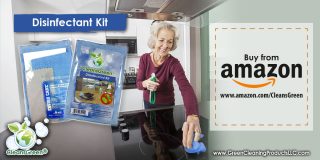
We learned how to clean from our Mothers while we were kids playing grown up. Once we learned the “tricks of the trade” rarely did we question them, much less adjust the practices involved. As such many cleaning techniques we learned were never dispelled and are in reality myths. One such myth is that disinfecting and cleaning are the same.
Disinfecting and Cleaning are the NOT Same ~ It’s a Misnomer
Cleaning and disinfecting is one of the most misunderstood concepts in the world of cleaning. Cleaning is a way to remove dirt and grime at a surface level. Disinfecting, on the other hand, frees the surface of microscopic organisms by killing things like the bacteria, viruses and fungi which can lead to infections or disease. At the same time it is important to avoid Disinfectant Overload.
The cleaning process removes many of the sources that will propagate germs. Hence cleaning is an important step to prevent the spread of bacteria and diseases. Moreover, the more debris that is removed during the cleaning stage, the better a disinfectant will be able to do its job.
That said, the traditional practice of spray and wipe may not be effective in that that cleaning solutions do not necessarily work instantly. Follow the directions on the product’s label, as some cleaners need to sit 2 to 3 minutes before removal.
When disinfecting, it is definitely NOT just a spray and wipe process! This is a situation where reading the label is critical. In doing so you will find, most disinfectants instruct you to SPRAY UNTIL WET, leave on the surface for at least 10 minutes (dwell time), remove the disinfectant, and then rinse the surface.
Clearly the proper application of disinfectants is MUCH more than involved than the spray and wipe strategy we are used to. In fact, by law, all disinfectants must be registered with the EPA and applicable label instructions on EPA-registered products must be followed.
Cleaning products are generally designed to be either a cleaner or a disinfectant, but rarely both.
Are You a DIY-er?
 A note for the DIYers, bleach and vinegar are two common household solutions that get mixed up. As naturalist, John Muir pointed out, “When we try to put anything by itself, we find it is connected to everything else in the universe.”
A note for the DIYers, bleach and vinegar are two common household solutions that get mixed up. As naturalist, John Muir pointed out, “When we try to put anything by itself, we find it is connected to everything else in the universe.”
Bleach is a disinfectant (kind of). This means that it may kill bacteria and other viruses on a surface but does not clean it. If you are looking to disinfect an area, it is best to clean the surface before disinfecting.
Vinegar, unlike bleach, does NOT kill microorganisms so it is only a cleaner, not a disinfectant.
The CleansGreen® Disinfectant Cleaning Kit is unique as it contains the EnviroCare Neutral Disinfectant cleaner concentrate along with a matching color-coded plush terry type microfiber cloth.
EnviroCare Neutral Disinfectant is a unique product. While it is hospital grade, it is also pH neutral, as opposed to others that are a strong base with a high pH of 11 to 13. (pH is a numeric logarithmic scale used to specify the acidity or basicity (alkalinity) of an aqueous solution. Harmful effects become noticeable when the pH of water falls below 5.0 or rise above 9.6. High pH levels can damage of aquatic organisms and can even cause death at levels over 10.0.)
Since strong alkaline solutions can etch and destroy the surface (all the more reason for that time-consuming task of rinsing after the appropriate dwell time). The greatest benefit of the EnivroCare pH neutral disinfectant is that it can air dry after application. No rinsing is required after the dwell time, thus reducing a steps in the arduous process is a huge time and money saver.
The Bottom Line from CleansGreen®
 Cleaning and disinfecting are mutually exclusive. Cleaning does not mean disinfecting. Disinfecting does not mean cleaning. The proper method is a multi-step process of first cleaning then followed by disinfecting including the critical dwell time step.
Cleaning and disinfecting are mutually exclusive. Cleaning does not mean disinfecting. Disinfecting does not mean cleaning. The proper method is a multi-step process of first cleaning then followed by disinfecting including the critical dwell time step.
Knowledge is powerful. Sign up for the eBook by Green Cleaning Products LLC, “The Bottom Line: Cleaning Myths Busted by CleansGreen®” to learn more about other common cleaning myths,


